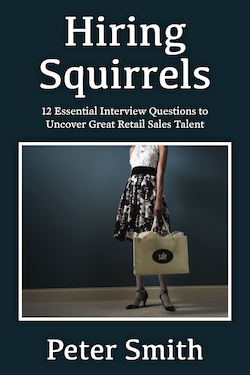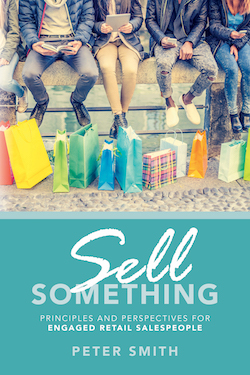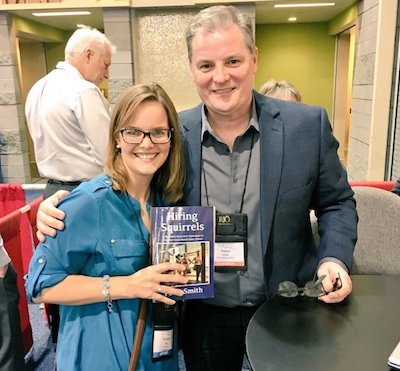Articles and News
The Changing Landscape For Independent Jewelers | December 07, 2016 (0 comments)

Merrick, NY—So far in 2016, more than 981 North American jewelry stores have ceased operations. The latest—Beauchamp Jewelers in Albuquerque, NM and Washington Jewelers in Washington, NC—are two more upscale stores whose owners are retiring. Add in the 760 stores that closed last year and we may see more than 2000 jewelers close in the 24-month period since January 2015.
What’s happening to our industry? Is it just that jewelers are getting old? The dearth of young people choosing careers in jewelry is something industry leaders have been worried about for some time. But is that all? The Centurion interviewed noted author and columnist Peter Smith—also president of VIBHOR—to see what all this means to the future of our industry. At left: Peter Smith during a presentation at the JCK Show.
The Centurion Newsletter: These statistics look dire, but is there a silver lining in all the bad news?
Peter Smith: Absolutely, yes! First, look at retail as a whole. It’s easy to be consumed by the statistics in our own industry and ignore the much larger retail world in which we operate. EKN Research predicted the retail business in the United States is about $3.7 trillion this year—far beyond the $78 billion generated by jewelry and watches. Furthermore, EKN predicts that will grow to $7 trillion by 2024. That’s only seven years from now, so those numbers would be very reassuring to me if I were starting a retail business today.
Unless you believe people are just not interested in buying jewelry anymore—which I don’t believe for a minute—our industry will survive. But there will be fewer players in it, and that presents more opportunities for the right retailers. I believe the contraction we are seeing will be good in the long term because it will force both retailers and wholesalers to re-think our approach. Those that evolve their business models and execute well can be very optimistic about the future, but the key is ridding ourselves of any sense of entitlement. Business as usual won’t cut it in the coming years. That ship has sailed.
The Centurion: What retail models we can learn from?
Smith: It’s almost passé to suggest Apple again, but we would do well to understand how brilliantly focused they are in their product offerings and how obsessive they are in getting the customers in and out of their stores with minimal hassle. Those two principles—focused product and customer experience—are powerful lessons for any business.
Closer to home, look at Tiffany & Co. I’ve often heard retailers talk about the ‘Blue Box’ as though that gives Tiffany a divine right to business regardless of how they perform. But look at the model they’ve created in their newer stores. They have not tried to replicate their Fifth Avenue store and everything that was, they have taken a focused approach and executed a pared-down model featuring their very best stories: Paloma Picasso, Elsa Peretti, et cetera. They’ve had some challenges in same-store sales domestically, but you’d be a fool to bet against them in the near and long term. Like Apple, they occasionally open an iconic store in a major international city, but most of their stores are leaner and more focused on their best product stories.
I also suggest independent jewelers look hard at the best Kay Jewelers stores. We are quick to dismiss the majors, thinking it’s a different customer and we have nothing to learn from them. Quite the contrary! It’s not about ‘competing’ with Kay, it’s about learning from every source we can to drive ourselves to better performance.
There are three areas where I think Kay excels. First, they’ve demonstrated a real command of marketing, especially the power of emotional communication and story-telling. Watch their commercials and you will see a clear commitment to engaging customers on an emotional level.
Two, their people. I had occasion to visit about 30 to 40 of their top stores a few years ago and I was very impressed with the quality of their store managers and top salespeople. That doesn’t mean every Kay Jewelers store is staffed at that level, but the best ones are and it speaks well to their recruiting and training processes.
Finally, I have seen a remarkable evolution in their merchandising strategy. With strong echoes of their advertising, the best Kay stores are vehicles for great storytelling, with a finite number of brands being merchandised and executed exceptionally well.
The Centurion: What does the growth of online mean for independent jewelers?
Smith: First dispense with the myth that brick-and-mortar stores are going away because of online sales. That’s a cop-out. Yes, e-commerce will continue to grow at a steadier clip than brick-and-mortar stores, but to believe it will render the retail experience redundant is complete nonsense. In EKN’s projection for a $7 trillion retail business by 2024, they forecast 15% of that will be online. A similar Bain & Company forecast puts 20% of all luxury purchases online by 2025. Do the math! That’s still 80% - 85% percent of $7 trillion in sales coming from physical stores; a massive amount of business to go around!
Doug Stephens wrote in The Retail Revival, “There are two things to keep in mind. First, at its core, shopping is a social activity. We shop not only to gather and acquire things we need, but also to commune in public places, to be with people. I’ll be the first to argue that online stores will get better and better at fulfilling the distribution aspect of shopping, but I will also hold that nothing will entirely replace the social experience of visiting the market. Second, although the list of things we as consumers are comfortable buying online grows each year, there are still things that are simply more confidently purchased in a physical store setting.”
Jewelry retailers must have a strong digital presence to support their physical operation. It must include a great mobile-friendly website that communicates and underscores the exact messaging you are delivering in your store, in your traditional advertising, and throughout your social media platforms. Aligning all those message points seems obvious, yet finding retailers that demonstrate clear and consistent messaging across their respective marketing platforms is, quite honestly, more the exception than the rule.


Peter Smith is the author of two books dedicated to better retail sales.
The Centurion: Can you speak to social media and Millennials, two separate and yet very intertwined concepts?
Smith: Yes, and those two concepts are also connected by myths that surround them. Retail jewelers complain that Millennials don’t shop in their stores (insert your own excuses here) and that social media outreach doesn’t work.
Watches and jewelry is a $78 billion business, and our number-one customer demographic is 55 – 64 years. We naturally cater to our best customers and, to borrow from the infamous bank robber Willie Sutton, it’s where the money is. Ignoring that demographic would be a grave mistake for many reasons.
But if you remove watches from the equation, jewelry is a $69 billion business whose number-one demographic is Millennials. No matter how unlikely that seems, it is true! Driven by the more than two million marriages a year, Millennials are spending their hard-earned money in bricks-and-mortar retail stores because despite their digital acumen, a great many of them still would rather buy their engagement and wedding rings in a store.
Everyone wants to believe Millennials would rather shop online, but the numbers tell a different story. Amazon and Blue Nile, the two biggest players in online jewelry and watches, do about $1 billion between them in the category. That’s $1 billion of a $78 billion business, hardly evidence of a bricks-and-mortar Armageddon. Not to mention that both those digital behemoths are now adding bricks and mortar operations to their respective portfolios.
The Centurion: Millennials are willing to spend for bridal, but when you take that category out of the equation, things start falling apart.
Smith: The question we need to be asking is why are Millennials not excited about retail jewelry stores after they purchase their engagement and wedding rings? Why do so many of them either not buy jewelry at all, or feel less committed to visiting those same retail stores for future purchases?
I suspect that speaks to relevance—or lack thereof—and that’s the puzzle to be solved. They obviously felt strongly enough about their ring purchases to visit a local jeweler instead of shopping online, yet they likely didn’t connect enough with what they found there to sustain a longer-term relationship. I believe that speaks to the need to look hard at creating a much-improved experience when they are in the store. To a large extent, we still operate with a version of the way things have always been and that needs to change.
Social media has now surpassed print, radio, out-of-home, and catalogs as the second-biggest Millennial influencer behind television—and one wonders how long it will be before it surpasses even that. Having a business without a strong social media presence is delusional. You’re not going to be successful without speaking to current and prospective customers on the platforms that matter to them. And, at the risk of being redundant, your messaging must be consistent across all your touch-points and it must align with what you are trying to communicate about who you are as a business.
To sum up the Millennial/social media combination, jewelers must create a real sense of what their store is about, and communicate that across all their social media in a way that is interesting and easily consumed by millennials. It can’t be all about buying—there must be a constant flow of engaging content so they see your business as a source of interesting material AND a good place to shop.
Centurion: Do retailers always need to find something new to make themselves viable?
Smith: No. In fact, I would argue the biggest issue with our industry is that we have too much stuff already. We are drowning in irrelevant products, while the lesson from Tiffany and Apple is doing more with less. Retailers should decide what sort of business they want to be, then go narrow and deep with products, stories, and brands, and sing it from the rafters.
Too often, we’re hell-bent on finding the next tennis bracelet; i.e. the next great thing. Forget about it. While there will always be a place for exciting new designers and product introductions, they should be built upon the foundation of what you want your business to be—and that shouldn’t change from one tradeshow to the next.
Centurion: Where’s the balance between having enough new to keep things exciting and remaining true to your foundation?
Smith: The idea that a retailer would ever be out of stock on a best-selling product is ridiculous, and yet that happens all the time. I see retailers who are much more interested in what’s new even as they have holes in their core inventory. Adding new designs, new vendors or new brands ought to be done when it absolutely aligns with your vision for your company, not just because everybody else is doing it. Anything else is a distraction—and usually a very expensive one.

Peter Smith with an attendee at the RJO Show.
Centurion: What do you tell retailers who complain about low foot traffic?
Smith: I suggest they answer four key questions: 1) Do they have a door counter? 2) How are they measuring their conversion rates? 3) How effective is their sales team in closing sales? 4) What specific actions are they taking to drive traffic?
Door Counter. If you don’t have at least a rudimentary door counter, you should lose the right to complain about foot traffic being down. There’s simply no reason at all why you can’t install a basic—or better yet—more advanced-system to understand who is coming into your store. Click here and here for two examples of door counter systems.
Conversion. Once you know how many people are coming in, you can assess your [sales] conversion rate based on real data, not intuitive or self-serving attitudes (i.e., that wasn’t a real customer). Knowing how well you are converting is an essential measure of your team’s effectiveness. Customers are the most precious resource in retail stores and no business can afford not to close them at an appropriate rate.
Sales Team. If you are not converting at an appropriate clip, you may have an issue with your sales team. I say “may have an issue” because you might have a lousy product mix, few best-sellers, and a poor customer experience. But if—as is more likely the case—the lack of conversion is due to poor performance from the sales team, change it. Don’t complain, change it up. You don’t have to fire four or five people at once, but you can make one great hire and begin to change the game. I have seen a single new hire transform the fortunes of some retail stores that had previously been struggling prior to that hire.
One great hire at a time will get it done—if you have a structured hiring process to find that talent (read more about that here). By the way, that person is probably not working at your competitor—and may not currently be working in sales at all.
Marketing. This goes back to my previous comments about having a clear sense of who you want to be and—very importantly—who you do not want to be. If you are delivering a clear message to your target customers using the platforms they use, you should see the effects in your store in improved foot- traffic. Paradoxically, that may not increase foot traffic at all but it should drive a more targeted customer to your business. It’s then up to your team to create a great customer experience and convert them.
If you just want more feet in the door, have a close-out sale. If you want ongoing higher sales, you need the right customers and the right salespeople to convert them.
Centurion: But aren’t a lot of stores closing because the owners just want to retire?
Smith: People have always retired. The difference now is that there are far fewer businesses being taken over by the next generation or being bought by someone else. But this is another huge topic that deserves its own analysis, so let’s come back to it in January after the holidays are over.
Centurion: Do you have any closing thoughts for now?
Smith: I love this business and besides making my living in it, I spend inordinate amounts of time thinking, reading, and learning about the retail side of our business. We have great opportunity, but I get frustrated by the litany of excuses: the Internet, Millennials, anything and everything except a good hard look in the mirror. If we are not executing at a high level in the most important areas of business—the right people, focused brands and product stories, great customer experiences, consistent marketing, proactive clienteling and so forth—how can we blame outside sources?
I am a great admirer of baseball biographies. Charles Leerhsen’s Ty Cobb, A Terrible Beauty quotes Cobb as saying, “Most struggling hitters feel their way is best, for them at least, and wish to be left alone so they can further ingrain the habits that have not served them well.”
For jewelers, further ingraining habits that used to work but which no longer do leads to the same end.
There is a bright future for retailers who accept that the old model might not be working and who are willing to learn and make the brave changes necessary to be successful in today’s marketplace. That, and an occasional sprinkle of humility, is a good starting place to chart your future.
Peter Smith can be reached at Peter@Vibhorgems.com, on LinkedIn, or via HiringSquirrels.com. Follow him on Twitter: Peter Smith @HiringSquirrels.







